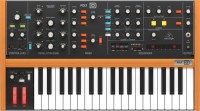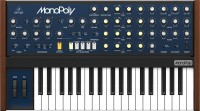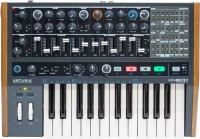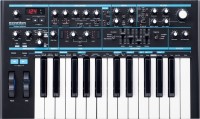Behringer Poly D
 |
Behringer Poly D | |||||||||||||||||||||||||||||||||||||||||||||||||||||||||||||||||||||||||||||||||
|
| ||||||||||||||||||||||||||||||||||||||||||||||||||||||||||||||||||||||||||||||||
Always clarify the specifications and configuration of the product with the online store manager before purchasing.
Catalog Behringer 2025 - new arrivals, bestsellers, and the most relevant models Behringer.
The original Minimoog synthesizer hit the market back in 1970 and changed the music world forever. If earlier electronic instruments seemed like a curiosity, then with the release of Minimoog, many bands and studios realized that the synthesizer can be as important part of a musical ensemble as drums, guitar, keyboards and vocals. The replica from Behringer carefully treats its heritage and includes the entire Moog set: three independent oscillators with several types of waves, a proprietary low-pass ladder filter, a pair of envelopes and an LFO with modulation settings, as well as built-in chorus and distortion, which were not there in the classical model. Also, the capabilities of the original synthesizer were expanded with a built-in 32-step sequencer, which also can turn into an arpeggiator.
Polyphonic Minimoog
Well, the main difference from the original is the support for polyphony. The regular Minimoog and its official reincarnation Minimoog Model D are monophonic synthesizers, i.e. they can only play one note at a time. At one time, this limitation was circumvented by changing the pitch of the oscillators. For example, the first one plays the note C, the second one plays the note E, and the third one plays the G, thanks to which together we hear a major chord. This approach was especially appreciated by techno producers who could play chords with a single key. But the keyboard players weren't happy about it. The version from Behringer removes any restrictions on the use of playing this way and that.
And now it's time to move on to the question, what about the sound? Behringer says that they have recreated the original circuit diagram by 99% and only the owner of perfect hearing can somehow distinguish them. As tests on YouTube and online reviews show, there are only a few such people in the world, so most people are 100% satisfied with the purchase. And the difference in price remains noticeable - Behringer asks 700 Euros for its work, while the prices for the original Minimoog can reach 6 – 7K Euros. By the way, if you don't need physical keys, Behringer has a more accessible and slightly simplified version of this synthesizer called Model D. It does not have a keyboard, built-in effects and sequencer. It does have a bunch of CV inputs, though, which makes it an interesting option to use with a modular system.
































